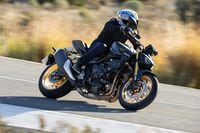Wolfgang Dürheimer bears the formidable task of running Bentley and Bugatti, two of the world’s most exclusive car brands. But the lanky German is perhaps the ultimate embedded motorcycle enthusiast. An avid trials and touring rider, Dürheimer launched his two-wheel career with a senior thesis dedicated to the BMW GS. Cutting his teeth as a motorcycle race mechanic developed insights that would later help him guide Bentley’s return to racing in 2013, and his tenure as head of R&D at BMW Motorrad grounded his engineering instincts to the realities of manufacturing, skills that no doubt became useful when he oversaw development of the $3 million, 1,500-hp Bugatti Chiron. We caught up with Dürheimer to get the scoop on the roots behind his motorcycle passion.
Q: You played a key role in developing the BMW GS's Paralever suspension. How did that come about? A: The GS was originally developed for the International Six Days Trial, but its rear suspension was causing extreme problems in motocross. I wrote a letter to the person in charge of BMW testing and told him, "I'm a student, I like motorcycles, and I would like to find a solution to your problem." I did deep theoretical analysis and developed five different solutions using a programmable Texas Instruments TI-56 calculator, studying what happens with the contact patch over the travel of the suspension. BMW later agreed to build a prototype of my suspension design. To show it worked, I parked at the bottom of a set of stairs and said, "I'm not pushing the bike upstairs." Of course, it worked.
Q: You worked as a BMW factory mechanic at the Paris-Dakar Rally four times in the early 1980s and led Gaston Rahier to victory twice. What was that like? A: If you were a motorcycle racing aficionado searching for the extreme, the Paris-Dakar Rally was the place to be. It was 21 days in Africa with no hotel, no shower, no nothing. To work without lights under a sky loaded with stars and preparing your bike for the next stage… I look back, and it was one of the most thrilling experiences I've had. Gaston was a very interesting man—very focused, very fast, but very demanding. For instance, when everything seemed perfect just two minutes before a race, he said, "My throttle is 2mm too far to the left." So the others said he's mad, he's crazy—who cares? I took my screwdriver and moved it 2mm to the right. In order to help get him to the limit, you had to give him what he wanted.
Q: How does Ducati fit into the Volkswagen Group? A:I think Ducati ended up really happy to be within the Volkswagen Group because we did not interfere with their product portfolio. I wouldn't compare Ducati directly with Bugatti, but in a certain way they deserve to be compared: Ducati is at the top. They are very sharp, they have models that cost more than 100,000 euros, and they are not diluting their image. Usually when manufacturers have a wider portfolio they are tempted to grow in different segments—for instance, Ducati successfully resisted building a scooter.
Q: I love that you vacation every summer with your family on motorcycles. What's special about those experiences? A: My family is a very important part of my life. Unfortunately, they don't get a lot of time because I'm often traveling, so I try to create experiences that bring everybody together. Both of my kids enjoy riding: Our son rides a Ducati 899 Panigale, and our daughter has a BMW F800. Last year, I was on a BMW R1200GS that I recently sold, and I'm out to get the BMW R1200GS Rallye. Last year, we crossed the Alps and down to St. Tropez. Everybody has fun with it; I think it's the best time you can have. It's just a great experience.
Q: Do you have a dream motorcycle trip? A: I have a list of unfinished business I keep with my wife, and one of the trips we intend to do—not in a single piece but maybe in three or four chunks—is to ride Highway 1 from Alaska to Patagonia. I always read about Alaska in the summertime and how pretty it is when everything flourishes; there are maybe two or three months when the energy is in the ground and everything is beautiful. The first stop will most likely be Seattle or San Francisco, the second one will be San Diego, and then we will probably take a ferry around Central America to Brazil, Argentina, and Chile then head south.











/cloudfront-us-east-1.images.arcpublishing.com/octane/EOO6W43R6CVWTJ24XVNLNNSN5I.jpg)
/cloudfront-us-east-1.images.arcpublishing.com/octane/OKWOJWAKP5EP3OACCRRWPCIX2Q.jpg)
/cloudfront-us-east-1.images.arcpublishing.com/octane/2WF3SCE3NFBQXLDNJM7KMXA45E.jpg)
/cloudfront-us-east-1.images.arcpublishing.com/octane/G4MG6OUCJNBSHIS2MVVOTPX65E.jpg)
/cloudfront-us-east-1.images.arcpublishing.com/octane/IIGGWFOTOJGB7DB6DGBXCCMTDY.jpg)
/cloudfront-us-east-1.images.arcpublishing.com/octane/QSTCM6AVEZA5JJBUXNIQ3DSOF4.jpg)
/cloudfront-us-east-1.images.arcpublishing.com/octane/U4I7G625B5DMLF2DVIJDFZVV6M.jpg)
/cloudfront-us-east-1.images.arcpublishing.com/octane/B6XD6LS6IVCQPIU6HXDJSM3FHY.jpg)
/cloudfront-us-east-1.images.arcpublishing.com/octane/ICL63FEDDRDTTMINYICCEYGMDA.jpg)
/cloudfront-us-east-1.images.arcpublishing.com/octane/FCGZHQXRBZFLBAPC5SDIQLVF4I.jpg)
/cloudfront-us-east-1.images.arcpublishing.com/octane/WNOB6LDOIFFHJKPSVIWDYUGOPM.jpg)

/cloudfront-us-east-1.images.arcpublishing.com/octane/X33NU3E525ECRHXLNUJN2FTRKI.jpg)
/cloudfront-us-east-1.images.arcpublishing.com/octane/6KKT5NNL2JAVBOXMZYS5ZO76YA.jpg)
/cloudfront-us-east-1.images.arcpublishing.com/octane/J5RKG5O455GMPGQRF2OG6LRT7A.jpg)
/cloudfront-us-east-1.images.arcpublishing.com/octane/GX2CIZKQVRH2TATDM26KFG2DAE.jpg)
/cloudfront-us-east-1.images.arcpublishing.com/octane/ZWIDYSAKQZHD5BHREMQILXJCGM.jpg)
/cloudfront-us-east-1.images.arcpublishing.com/octane/CYUHJZCTSJCH3MRAQEIKXK7SCQ.jpg)
/cloudfront-us-east-1.images.arcpublishing.com/octane/LKOFINY56FCXJCANJ5M7ZDQUBY.jpg)
/cloudfront-us-east-1.images.arcpublishing.com/octane/4NBPDACMWJH63JQYJVK3QRBDZI.jpg)
/cloudfront-us-east-1.images.arcpublishing.com/octane/KKHQHRR3FJGX7H2IPU6RALMWG4.jpg)

/cloudfront-us-east-1.images.arcpublishing.com/octane/5IOFS5JAE5FOXMNA23ZRAVVYUU.jpg)
/cloudfront-us-east-1.images.arcpublishing.com/octane/CGXQ3O2VVJF7PGTYR3QICTLDLM.jpg)
